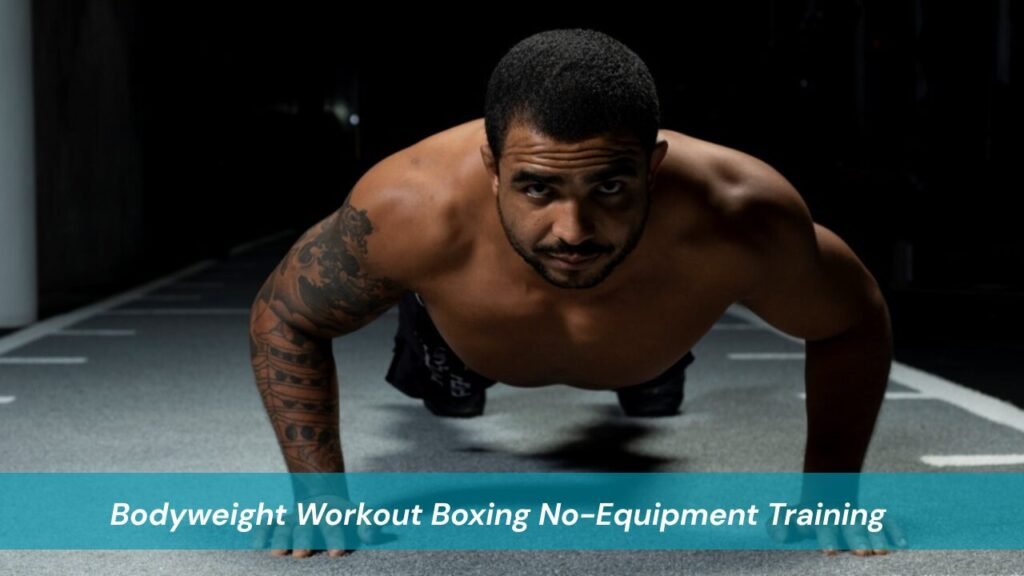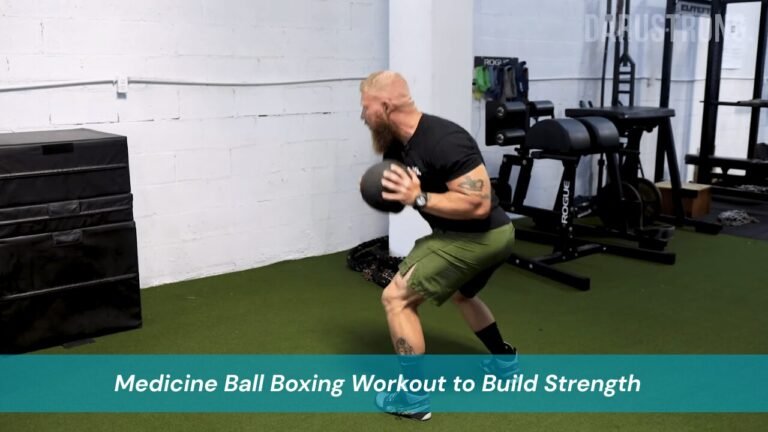Boxing is one of the most physically demanding sports in the world, requiring a combination of speed, strength, agility, and endurance. To perform well inside the ring, fighters must prepare their bodies with workouts that replicate the intensity of a match. While lifting weights and using gym equipment can certainly play a role in conditioning, some of the most effective training comes from simple, equipment-free movements. A bodyweight workout for boxing offers a functional, versatile, and highly effective way to build fight-ready fitness without the need for machines or weights.
By relying on natural body movements, boxers can strengthen the muscles most responsible for punching power, increase stamina for long rounds, and improve agility for defensive maneuvers. From explosive push-ups to grueling burpee circuits, bodyweight training not only conditions the body but also sharpens the mental toughness needed to succeed in boxing.
Why Bodyweight Training is Essential for Boxing
Every boxer knows the importance of being able to deliver a powerful punch and maintain stamina across multiple rounds. However, success in boxing is not built on sheer muscle alone. Fighters must have coordination, mobility, and explosive athleticism. Bodyweight exercises naturally train all of these areas because they replicate the kinds of movements boxers use in the ring.
Unlike traditional weightlifting, which often isolates muscles, bodyweight workouts use compound movements that engage multiple muscle groups at once. For example, a push-up strengthens the chest, shoulders, and triceps while also engaging the core, which plays a critical role in generating power behind punches. Squats, lunges, and jump variations strengthen the legs while improving footwork and balance, which are essential for both offense and defense.
Another key advantage of bodyweight training for boxing is its accessibility. Since no equipment is needed, boxers can train anytime and anywhere at home, in the gym, or even outdoors. This flexibility makes it easier to stay consistent, which is one of the most important factors in developing boxing fitness.
Finally, bodyweight workouts are highly adaptable. Beginners can start with standard variations of exercises, while advanced fighters can increase intensity by adjusting tempo, reps, and rest intervals. This makes it a long-term training solution that grows with a boxer’s development.
Key Principles of a Bodyweight Workout for Boxing
To make bodyweight training truly effective, it should be tailored to the specific needs of a boxer. Strength alone is not enough; a fighter must also be explosive, fast, and capable of sustaining high intensity for several rounds. A well-structured bodyweight workout for boxing follows five key principles.
First, explosive movements are a priority. Boxers rely heavily on fast-twitch muscle fibers for quick, powerful strikes and defensive movements. Exercises like jump squats, burpees, and plyometric push-ups help develop this explosiveness.
Second, endurance must be built into training. Boxing matches are grueling, often lasting multiple rounds with little rest. High-intensity bodyweight circuits replicate this by pushing cardiovascular and muscular endurance simultaneously.
Third, core strength is non-negotiable. A strong core is what connects the lower and upper body, allowing fighters to generate maximum punching power. Planks, twists, and rotational movements should always be included.
Fourth, agility and mobility cannot be ignored. Footwork is the foundation of boxing, and bodyweight drills that challenge balance, speed, and lateral movement prepare a fighter for real ring scenarios.
Finally, progressive overload ensures continuous improvement. This means gradually increasing difficulty over time, whether by doing more repetitions, shortening rest periods, or performing advanced variations of exercises.
Full-Body Bodyweight Workout for Boxing
To put these principles into action, here’s a sample bodyweight workout routine designed for boxers. This circuit targets the entire body, builds cardiovascular endurance, and sharpens explosive movement.
Start with a warm-up of five to ten minutes. Jumping jacks are excellent for raising the heart rate, while arm circles, hip rotations, and dynamic stretches prepare the joints. Finish the warm-up with light shadowboxing, focusing on relaxed footwork and head movement.
Once warmed up, begin the circuit. Push-ups should be performed first, aiming for 15 to 20 reps to strengthen the chest, shoulders, and arms. Immediately follow with squat jumps for 12 to 15 reps to build explosive leg strength. Next, hold a plank while alternating shoulder taps for 20 repetitions to engage the core and improve shoulder stability. Move on to 10 to 12 burpees, which challenge the entire body and simulate the explosive energy required in fights. Then, perform mountain climbers for 30 to 40 seconds to raise the heart rate and strengthen the core. After that, execute 12 plyometric lunges on each leg to improve balance and agility. Conclude the round with one minute of shadowboxing at high intensity, focusing on quick combinations and constant movement. Rest briefly before repeating the circuit three to five times.
This workout is challenging, but it reflects the demands of a boxing match by combining strength, endurance, and agility in one continuous routine.
Core-Focused Bodyweight Training for Boxers
A boxer’s core is the foundation of every punch. Without strong abs, obliques, and lower back muscles, even the most skilled fighter will struggle to generate power or maintain stability under pressure. A dedicated core routine can dramatically improve a boxer’s ability to perform.
Russian twists are excellent for rotational strength, which translates directly into harder hooks and body shots. Leg raises strengthen the lower abs, which are critical for maintaining balance while moving around the ring. Holding plank variations for up to a minute builds both endurance and stability, helping fighters keep their form even during fatigue. Bicycle crunches combine abdominal strength with rotational coordination, which closely mimics the twisting motion of throwing punches.
For added challenge, fighters can perform advanced movements such as plank-to-push-up transitions or V-sits, both of which engage multiple muscle groups at once. Consistently training the core ensures that a boxer can generate power efficiently and remain steady under pressure.
Conditioning Drills Without Equipment
Cardio conditioning is perhaps the most vital part of boxing training. Without stamina, even the strongest fighter will falter. Fortunately, bodyweight drills can provide the same conditioning benefits as equipment-based workouts.
High knees are one of the simplest yet most effective drills, raising the heart rate quickly and improving leg speed. Bear crawls across 20 meters engage the shoulders, core, and legs while building endurance. Skater jumps force the body to move laterally, which improves balance and simulates evasive movements. Short sprints or shuttle runs lasting 20 to 30 seconds help develop explosive endurance and the ability to recover between bursts of activity just like in a real fight.
These conditioning drills can be arranged into interval-style workouts, such as performing 30 seconds of each exercise with minimal rest in between. This format closely mirrors the round structure of boxing and ensures fighters build the ability to sustain effort under fatigue.
Weekly Bodyweight Workout Plan for Boxing
Consistency is key in boxing training, and a well-designed weekly plan ensures progress without overtraining. A balanced bodyweight program should combine full-body strength circuits, core routines, and conditioning drills.
For example, begin the week with a full-body circuit that includes push-ups, squats, planks, and burpees, followed by a short core session. On the second day, emphasize conditioning with drills like sprints, bear crawls, and shadowboxing. The third day should be reserved for active recovery, such as yoga, stretching, or light footwork drills. The fourth day can focus on explosive power with plyometric push-ups, jump squats, and rotational core exercises. The fifth day should emphasize upper-body endurance with high-rep push-ups and plank variations. On the sixth day, perform another conditioning circuit that replicates the intensity of a fight. Finally, use the seventh day for rest or light shadowboxing to keep the body moving without strain.
This schedule allows fighters to train multiple aspects of fitness while ensuring they recover enough to continue progressing.
Tips for Getting the Most Out of Your Bodyweight Training
While bodyweight workouts are simple, there are ways to make them far more effective. Always prioritize proper form, as poor technique can lead to injury and limit progress. Pair bodyweight training with actual boxing drills, such as heavy bag work or sparring, to make sure conditioning translates into performance. Training with timed intervals instead of fixed reps is highly recommended since it simulates real fight rounds and improves pacing.
Tracking progress is another important habit. Keep a log of the number of rounds, repetitions, or duration of exercises and aim to improve gradually. Recovery also plays a critical role. Stretching after sessions, staying hydrated, and getting adequate sleep will maximize results and prevent burnout. Finally, mental discipline is essential. Bodyweight workouts can be intense, but pushing through fatigue builds the toughness that every fighter needs.
FAQs
Can bodyweight training replace weightlifting for boxers?
Yes, for many fighters, bodyweight training provides enough functional strength and endurance. However, advanced athletes may combine it with weightlifting for maximum results.
How many days per week should boxers do bodyweight workouts?
Three to five days per week is ideal, depending on the fighter’s overall training load and fight preparation schedule.
Is bodyweight training good for beginners in boxing?
Absolutely. Bodyweight workouts are beginner-friendly and offer a safe way to build strength, stamina, and coordination without requiring equipment.
Can I build punching power with bodyweight workouts?
Yes. Explosive bodyweight exercises such as plyometric push-ups, jump squats, and rotational core drills directly increase punching power.
Do I need equipment for bodyweight boxing workouts?
No equipment is required. However, optional tools like resistance bands or medicine balls can add variety and intensity as you progress.
Conclusion
A bodyweight workout for boxing is one of the most practical and effective ways to develop fight-ready fitness. By focusing on explosive movements, core strength, conditioning drills, and agility-based training, fighters can build the endurance, speed, and power needed to dominate inside the ring. Unlike equipment-heavy programs, bodyweight workouts are accessible to anyone, anywhere, and can be easily adapted for beginners or advanced athletes.
Whether you are shadowboxing in your living room or training at the gym, bodyweight exercises give you the tools to perform at your best. For boxers who want to sharpen their physical edge while keeping training simple and efficient, bodyweight workouts remain an essential part of the journey toward becoming a stronger, faster, and more resilient fighter.




